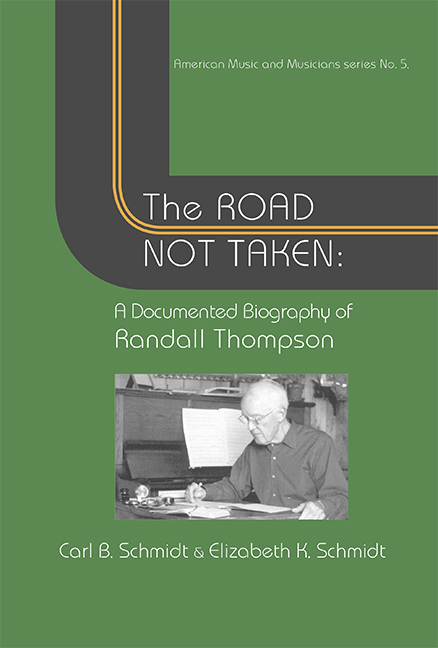Book contents
- Frontmatter
- Contents
- List of Illustrations
- List of Tables
- Library Sigla and Abbreviations
- Guide to Harvard University and Oberlin College Collections Referenced by Box Number
- Preface: Gateway to a Career
- Acknowledgments
- Chapter I Family History and Formative Years
- Chapter II Undergraduate Study at Harvard College (1916-20)
- Chapter III Lessons with Ernest Bloch and Graduate Study at Harvard University (1920-22)
- Chapter IV Damrosch Fellowship Years at the American Academy in Rome (1922-25)
- Chapter V Courtship and Marriage (1925-27)
- Chapter VI New York City—Wellesley College—A Guggenheim Fellowship (1927-31)
- Chapter VII Guest Conducting, Reception of Symphony no. 2, and College Music: An Investigation (1931-35)
- Chapter VIII Life after College Music: An Investigation (1935-37)
- Chapter IX The University of California at Berkeley (1937-39)
- Chapter X Curtis Institute of Music: The Hiring Process (Spring and Summer 1939)
- Chapter XI Curtis Institute (Fall 1939-Spring 1941)
- Chapter XII The University of Virginia (Fall 1941-Spring 1945)
- Chapter XIII Princeton University (Fall 1945-Spring 1948)
- Chapter XIV Return of a Favored Son: Harvard University (Fall 1948-Spring (1957)
- Chapter XV Harvard University (Summer 1957 to July 1, 1965)
- Chapter XVI The Early Retirement Years (1965-75)
- Chapter XVII The Final Years (1975-84)
- Chapter XVIII Recapitulation and Coda
- Bibliography of Works Cited by Abbreviations
- Index
Chapter V - Courtship and Marriage (1925-27)
- Frontmatter
- Contents
- List of Illustrations
- List of Tables
- Library Sigla and Abbreviations
- Guide to Harvard University and Oberlin College Collections Referenced by Box Number
- Preface: Gateway to a Career
- Acknowledgments
- Chapter I Family History and Formative Years
- Chapter II Undergraduate Study at Harvard College (1916-20)
- Chapter III Lessons with Ernest Bloch and Graduate Study at Harvard University (1920-22)
- Chapter IV Damrosch Fellowship Years at the American Academy in Rome (1922-25)
- Chapter V Courtship and Marriage (1925-27)
- Chapter VI New York City—Wellesley College—A Guggenheim Fellowship (1927-31)
- Chapter VII Guest Conducting, Reception of Symphony no. 2, and College Music: An Investigation (1931-35)
- Chapter VIII Life after College Music: An Investigation (1935-37)
- Chapter IX The University of California at Berkeley (1937-39)
- Chapter X Curtis Institute of Music: The Hiring Process (Spring and Summer 1939)
- Chapter XI Curtis Institute (Fall 1939-Spring 1941)
- Chapter XII The University of Virginia (Fall 1941-Spring 1945)
- Chapter XIII Princeton University (Fall 1945-Spring 1948)
- Chapter XIV Return of a Favored Son: Harvard University (Fall 1948-Spring (1957)
- Chapter XV Harvard University (Summer 1957 to July 1, 1965)
- Chapter XVI The Early Retirement Years (1965-75)
- Chapter XVII The Final Years (1975-84)
- Chapter XVIII Recapitulation and Coda
- Bibliography of Works Cited by Abbreviations
- Index
Summary
The “Pink Nimbus”
(Randall Thompson)
WORKING IN NEW YORK CITY 1925-26
The years between his arrival stateside in late October 1925 and his marriage in early 1927 were challenging but exciting for Thompson. First he had to find work and establish an American reputation, cultivate a number of impor¬tant musicians upon whom he could rely, and learn about the business aspects of his profession.
Once back, Thompson stayed briefly with his parents in Boston, where his father was headmaster of the Roxbury Latin School, before renting an apartment in New York's Greenwich Village in a four-story 1899 building at 180 Sullivan Street and taking up residence there. Looking back years later he recalled:
I had got back to New York in a kind of pink nimbus, with a lot of music under my arm and no cash at all. I decided to teach and write music for money. This worked for a couple of years, but was not lucrative enough as a basis for matrimony. Under these conditions my wife and I were married [on February 26, 1927].
He returned to a country in the middle of Prohibition (1920-1933), and a city, that was reported to have had more than 30,000 speakeasies to “ease the pain.” Moreover, 1926 was the year that saw the death of Claude Monet in France, the first use of 16 mm film in the United States, the publication of Hemingway's novel The Sun Also Rises, the opening of Martha Graham's first dance studio, and the impressive debut of the canine Rin Tin Tin as the biggest box office draw.
In spite of pecuniary angst, he returned with a growing group of in¬fluential friends: Howard Hanson was now Director of the Eastman School of Music in Rochester, New York and a prominent conductor; Leopold Mannes's parents headed the Mannes School of Music; Elizabeth Sprague Coolidge continued to support composers and performers in the States and abroad; Elwell and Sowerby were gaining prominence as composers; and Malipiero would give him sage advice concerning his Second Symphony in the early 1930s. Contact had been established with BSO conductor Serge Koussevitzky, and New York City boasted numerous influential Harvard alumni including Daniel Gregory Mason who congregated at places such as the Harvard Club and the Century Association where Thompson became a member.
- Type
- Chapter
- Information
- The Road Not TakenA Documented Biography of Randall Thompson, 1899–1984, pp. 179 - 202Publisher: Boydell & BrewerPrint publication year: 2018

